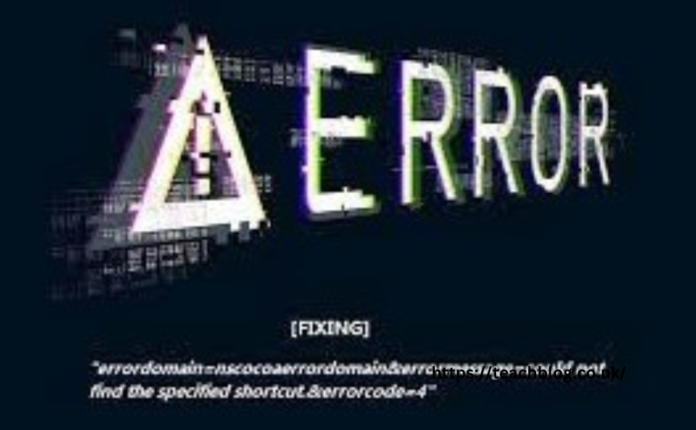Introduction
Errors are an inevitable part of software development, and understanding them is crucial for effective troubleshooting. One such error that developers and users alike may encounter in macOS or iOS environments is related to the NSCocoaErrorDomain. Specifically, the error message “could not find the specified shortcut” associated with error code 4 can be perplexing. This article aims to demystify this error, provide insights into its causes, and offer practical solutions for resolving it.
Table of Contents
What is NSCocoaErrorDomain?
The NSCocoaErrorDomain is a framework-specific domain in macOS and iOS environments that deals with errors related to the Cocoa framework. Cocoa is a key component of macOS and iOS, providing the underlying architecture for applications developed on these platforms. Errors within this domain typically arise from issues within the Cocoa API, which includes a wide range of functionalities like user interfaces, data management, and app infrastructure.
Understanding Error Domain Codes
Error domain codes are numerical identifiers associated with specific errors within a given domain. These codes help developers and users pinpoint the exact nature of an issue. In the case of NSCocoaErrorDomain, the error codes range from file handling errors to data conversion issues. Each code corresponds to a particular problem, and understanding these codes is essential for effective troubleshooting.
What Are Error Domain Codes?
Error domain codes are not exclusive to NSCocoaErrorDomain; they exist across various domains within macOS and iOS, such as NSURLErrorDomain for network-related errors and NSPOSIXErrorDomain for errors related to the POSIX (Portable Operating System Interface) standard. These codes provide a standardized way of identifying errors, making it easier for developers to understand and resolve issues.
The Error: errordomain=nscocoaerrordomain&errormessage=could not find the specified shortcut.&errorcode=4
The error message “could not find the specified shortcut” associated with error code 4 in the NSCocoaErrorDomain can be particularly frustrating. This error usually occurs when an application or system component tries to access a shortcut (like a file or a script) that does not exist or cannot be located. The error code 4 typically signifies a file or resource not found, which aligns with the issue of a missing shortcut.
How to Diagnose NSCocoaErrorDomain Errors
Diagnosing errors within the NSCocoaErrorDomain requires a systematic approach:
- Identify the Context: Determine when and where the error occurs. Is it during app launch, while executing a specific function, or when interacting with a particular file or shortcut?
- Check for Missing Resources: Since error code 4 often relates to missing files, verify that all necessary resources (shortcuts, files, scripts) are present and correctly referenced in your code.
- Use Logging and Debugging Tools: Utilize Xcode’s debugging tools and logging capabilities to trace the error’s origin. Breakpoints can be particularly useful for identifying the exact moment the error is triggered.
- Review Code and Configurations: Ensure that the code referencing the shortcut is correct. This includes checking file paths, ensuring the shortcut exists, and verifying that the app has the necessary permissions to access it.
- Consult Documentation: Apple’s developer documentation and forums can be valuable resources for understanding
NSCocoaErrorDomainerrors. They often provide insights into common causes and solutions for these issues.
Best Practices to Avoid NSCocoaErrorDomain Errors
Preventing NSCocoaErrorDomain errors involves adopting best practices in your development process:
- Maintain Clear and Consistent File Structures: Organize your project files in a logical and consistent manner. This reduces the chances of errors related to missing shortcuts or misreferenced resources.
- Implement Error Handling: Incorporate robust error handling mechanisms in your code. This allows your application to gracefully manage errors, providing informative feedback to users or taking corrective actions.
- Regularly Update and Test Shortcuts: Ensure that all shortcuts used within your application are up-to-date and functional. Regular testing helps identify broken or missing shortcuts before they cause errors.
- Utilize Version Control: Version control systems like Git can help track changes to your project’s files and shortcuts. This makes it easier to identify when a shortcut was altered or removed, aiding in error diagnosis.
- Leverage Continuous Integration/Continuous Deployment (CI/CD): Implementing CI/CD pipelines can automate testing and error detection, ensuring that issues like missing shortcuts are caught early in the development process.
FAQs about NSCocoaErrorDomain
- What does error code 4 in
NSCocoaErrorDomainsignify?- Error code 4 typically indicates a “file not found” or “resource not found” issue within the
NSCocoaErrorDomain. In the context of the error message “could not find the specified shortcut,” it suggests that the system or application was unable to locate a specified shortcut.
- Error code 4 typically indicates a “file not found” or “resource not found” issue within the
- How can I fix the “could not find the specified shortcut” error?
- To resolve this error, ensure that the shortcut in question exists and is correctly referenced in your code. Check file paths, ensure the correct permissions are set, and verify that the resource is accessible.
- Why do I keep encountering
NSCocoaErrorDomainerrors?- Frequent
NSCocoaErrorDomainerrors may indicate underlying issues with how your application handles files, shortcuts, or resources. Review your code and file management practices to identify potential problems.
- Frequent
- Can
NSCocoaErrorDomainerrors be avoided entirely?- While it’s challenging to avoid all errors, following best practices like maintaining clear file structures, implementing error handling, and regularly testing your application can significantly reduce the likelihood of encountering
NSCocoaErrorDomainerrors.
- While it’s challenging to avoid all errors, following best practices like maintaining clear file structures, implementing error handling, and regularly testing your application can significantly reduce the likelihood of encountering
- What tools can help diagnose
NSCocoaErrorDomainerrors?- Xcode’s debugging tools, including breakpoints and logging, are invaluable for diagnosing
NSCocoaErrorDomainerrors. Additionally, Apple’s developer documentation and forums can provide guidance on specific error codes.
- Xcode’s debugging tools, including breakpoints and logging, are invaluable for diagnosing
Conclusion
The NSCocoaErrorDomain and its associated error codes are integral parts of the macOS and iOS development environments. Understanding these errors, particularly the “could not find the specified shortcut” error with code 4, is crucial for maintaining robust and reliable applications. By adopting best practices, utilizing effective troubleshooting techniques, and leveraging available tools, developers can minimize the occurrence of these errors and ensure a smoother user experience.
As technology continues to evolve, staying informed about common errors and their solutions will remain a key aspect of successful software development. Whether you’re a seasoned developer or a newcomer to the world of macOS and iOS, understanding NSCocoaErrorDomain errors will empower you to build better, more resilient applications.



















